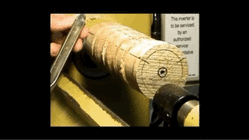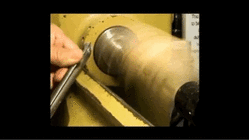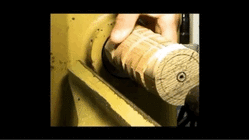- Joined
- Apr 27, 2004
- Messages
- 9,309
- Likes
- 6,081
- Location
- Lakeland, Florida
- Website
- www.hockenberywoodturning.com
I have been using a pull cut with an Ellsworth ground gouge to true cylinders for 20 years.
maybe someone knows why it works.
this cut is similar to a skew planning cut with the point down
i was reminded with the @Neil S thread on wing angles that my wing bevel angle on my bowl gouge is close to my skews bevel angle.
what I don’t understand is why the bowl gouge makes this cut end to end - air to air - Leaving a smooth surface end to end. No catches or splintering coming into the endgrain from air
it has nothing to do with skill Because I have had beginners make this cut flawlessly in workshops.
its pretty much a catch free cut if the nose of the gouge is kept out of the wood.
i could never cut in from air successfully using a skew.
a few clips from a 3 sided napkin ring demo videshow this cut
a preview of the cut- This spindle is mounted on three centers to cut three faces. the to be napkin rings are separated by parting cuts

The cut starting in air cutting from the edge. No catch no splintering

The finished surface is pretty clean.

any ideas on why this works?
I have thought bar crossing the edge of the cylinder gives support to the cutting edge but It just a guess.
maybe someone knows why it works.
this cut is similar to a skew planning cut with the point down
i was reminded with the @Neil S thread on wing angles that my wing bevel angle on my bowl gouge is close to my skews bevel angle.
what I don’t understand is why the bowl gouge makes this cut end to end - air to air - Leaving a smooth surface end to end. No catches or splintering coming into the endgrain from air
it has nothing to do with skill Because I have had beginners make this cut flawlessly in workshops.
its pretty much a catch free cut if the nose of the gouge is kept out of the wood.
i could never cut in from air successfully using a skew.
a few clips from a 3 sided napkin ring demo videshow this cut
a preview of the cut- This spindle is mounted on three centers to cut three faces. the to be napkin rings are separated by parting cuts

The cut starting in air cutting from the edge. No catch no splintering

The finished surface is pretty clean.

any ideas on why this works?
I have thought bar crossing the edge of the cylinder gives support to the cutting edge but It just a guess.
